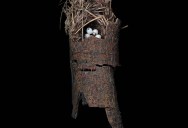25 Stunning Photographs of Birds’ Nests

MacGillivray’s Warbler Nest – Photograph by SHARON BEALS
Sharon Beals is an incredible photographer and artist. A self-proclaimed ‘urban naturalist’ that was raised in Seattle and now calls Hunters Point Shipyard in San Francisco, home. Sharon uses photography as an art form, and as a way to chronicle what moves her heart and concerns her conscience from habitat restoration and plastic in the ocean, to the ecology of rivers, and of course, birds’ nests. In her latest hardcover book ‘Fifty Nests and the Birds that Built Them’, Sharon showcases her gorgeous photographs of nests accompanied by fascinating and informative portraits of the builders themselves.
The Sifter had the pleasure of chatting with Sharon to learn more about her work, herself and what other projects she is working on. Enjoy the beautiful sample of nest photographs below and be sure to check out Sharon’s official site for more photographs and information!
*Important Note: The nest and eggs specimens, collected over the last two centuries, were photographed at The California Academy of Sciences, The Museum of Vertebrate Zoology, and The Western Foundation of Vertebrate Zoology.
2. American Robin’s Nest

Photograph by SHARON BEALS
3. House Finch’s Nest

Photograph by SHARON BEALS
4. Song Sparrow’s Nest

Photograph by SHARON BEALS
5. Allen’s Hummingbird Nest

Photograph by SHARON BEALS
SHARON BEALS – PHOTOGRAPHER
Tell us a bit about yourself
I am an urban naturalist, I guess, one of those people who has to live in a city for their work, and is also wedded to a group of friends who keep me sane and connected to culture in between my forays into the wild. While I have worked commercially as a photographer for over 25 years, I still try to make images that are my own, and lately that work has been focused on the quiet, subtle beauty of remnants of native habitat I find in between our altered terrain. This love of stick and twigs and wildness eventually led me to the nests, and to finding a voice for conservation both visually and with words.
I have a studio at Hunters Point Shipyard, one of the older artist communities in San Francisco, where I work on personal projects, show my prints and write. It is heaven for someone addicted to birdsong, as there are still some bits of nature remaining despite its former role as a naval base. It is also about a half mile from a waterfront wetland that I visit often.
What other projects are keeping you busy?
I am just returning to a project that I started while working on the book, which is making large scale scanned plastic prints from little assemblages of the plastic and other detritus I find on the beach. Besides working on the plastic, I hope to get trained on the microscope at The California Academy of Sciences so I can work on insects.
Who knows where that will lead me, but I am passionate about insects and their importance to birds, and us, and if I can be an art publicist for them, that would make me very happy.
6. African Palm Swift’s Nest

Photograph by SHARON BEALS
7. American Goldfinch’s Nest

Photograph by SHARON BEALS
8. Bank Swallow’s Nest

Photograph by SHARON BEALS
9. Black-Naped Oriole’s Nest

Photograph by SHARON BEALS
10. Caspian Tern’s Nest

Photograph by SHARON BEALS
50 NESTS AND THE BIRDS THAT BUILT THEM – ARTIST’S STATEMENT
A bird song, when heard above the urban pulse or the din of my mind, always gives me keen comfort, a reason to pause and wonder at those improbable notes, and to wash my eyes with the landscape of trees and sky to find its singer. Regrettably, it was years before I finally picked up binoculars to match more of the songs I was hearing to their singers. Guided by informed birders, I slowly began to parse the details of identification and habits.
It was the power of a book that turned mere identification into an unabashedly born-again passion. Scott Weidensaul’s moving and illuminating study of migration, Living on the Wind, was my awakening. Along with his accounts of birds banded, studied, or just observed in wonder on a world tour of research and researchers, he describes the senses and navigational cues that birds use to find their way on journeys that for some species can only be described as heroic.
The miles flown by a small but long-lived Arctic Tern can be equal to three trips to the moon and back. Half-ounce Blackpoll Warblers catch the trade winds far out in the Atlantic and fly south for 2000 miles without rest, food, or water. But besides describing how birds manage to accomplish these astonishing feats, he makes clear their need for the habitat that fuels and protects them along the way, and at either end of their passages.
Galvanized, I have become what I call a theoretical birder, one with a very short life list but on a quest to learn what birds need to be sustained both locally and globally. Yet how I could use my skills to say what was keening in my heart eluded me. It was only after making the first photograph of a nest, drawn to its palette and messy, yet graceful and functional form, that I knew I had found my medium––or at least a way that I could be a medium for the birds. I offer these photographs as a bowerbird lures a mate, with the hope that others will be as seduced as I to wonder and learn about the birds that built them.
11. Green Broadbill’s Nest

Photograph by SHARON BEALS
12. Arctic Redpoll’s Nest

Photograph by SHARON BEALS
13. Common Yellow Throat’s Nest

Photograph by SHARON BEALS
14. Grey Jay’s Nest

Photograph by SHARON BEALS
15. Magnolia Warbler’s Nest

Photograph by SHARON BEALS
BIRDS’ NESTS CONTINUED…
As of the latest estimate, there are about ten thousand avian species, with new ones still being discovered––or being elevated, thanks to DNA research, from subspecies to species status. While I have yet to photograph a megapode’s incubating mound, or a bristling citadel built by a century of Social Weavers, the fifty birds that built the nests that grace the pages of this book share construction skills or nesting strategies common to many who are counted in that great number.
A few document our presence in their lives, even historically, with a little, (or a lot) of our detritus. They tell tales of the materials available in their habitats, how complicated they are to build, and perhaps how much of a hurry they might be in to breed. Or whether camouflage is their defense or they need a fortress––each nest a bird’s best effort to protect and launch the next generation of their offspring.
What they don’t tell us is how hard for some that might be. For a few of these builders, rather than just offering the details of nest construction or charming anecdotes about creatures whose mystery allows us to romanticize them, there was no honest way to avoid telling that story. While many have adapted to, and even benefited from, human manipulations of their habitat, if that habitat is polluted, overrun by feral animals or introduced insects, or just gone missing, a whole species can be lost. I was drawn to photograph a few of these nests, collected long ago, simply for their form or the color of the eggs, only to discover that they had been built by a member of a species now so rare that we cannot be alarmed enough at their endangered status.
16. Western Gull’s Nest

Photograph by SHARON BEALS
17. Marsh Wren’s Nest

Photograph by SHARON BEALS
18. Tennessee Warbler’s Nest

Photograph by SHARON BEALS
19. Pine Siskin’s Nest

Photograph by SHARON BEALS
20. Galapagos Finch’s Nest

Photograph by SHARON BEALS
CONSERVATION
If you share my concern for these threatened birds, and want to keep others off that list, you might care to learn what has been made so clear to me: that so many of the decisions I make in my own daily life affect their survival. What I plant in my yard, what coffee I buy, what I put down my drain or into the atmosphere, or where I let my dog and cat wander, all of this matters. A lot.
Ninety-five percent of birds depend on insects to feed themselves and their offspring during breeding season. With an undeniably warming climate, this avian fuel is hatching earlier, often before the birds return to their breeding grounds. The nesting success of many species is already being affected. To add more urgency to this survival story, in North America we are down to a mere five percent of that buggy native habitat. Only a very few insects, and most of them alien imports themselves, can live off picture-perfect lawns, or the non-native and often invasive plants that seduce us at our local nurseries.
So much of how we affect birds is invisible to us from a distance; the wood for our floors and furniture is harvested somewhere, often irreplaceably. Our oh-so-soft brand-name tissues come from the last arboreal forests in Canada. The fruit we savor out of season was most likely grown on land once covered by a rainforest––and the same goes for coffee. The affordable prawns and fish in the freezer aisle could have been farmed in what were once tropical mangroves teeming with birds. Not to mention the plastic filling the bellies of sea going birds.
21. Rock Sparrow’s Nest

Photograph by SHARON BEALS
22. Western Kingbird’s Nest

Photograph by SHARON BEALS
23. Golden Masked Tanager’s Nest Inside Wild Honey Comb

Photograph by SHARON BEALS
24. Meadow Bunting’s Nest

Photograph by SHARON BEALS
25. Spotted Nightingale’s Nest

Photograph by SHARON BEALS
CONSERVATION CONTINUED…
I know I am beating this drum of concern late in a parade of conservationists who have been trying for a good part of a century to awaken us to planet-protecting changes that we all could, and need, to make. But these are changes that would also benefit our avian treasures, so please bear with me while I shout a few again: Learn about how much carbon you are putting into the atmosphere, and change that. Ride the bus, or a bike. Walk. And how much chemistry is innocently put into the water, never to be removed, in a culture obsessed with scent, beauty, and microbes?
Be a miser with that water (imagine it was carried home on your head). Simply use less stuff, especially plastic, and think about what everything you buy was made of, how far it was shipped, or if you might find it used. Buy shade grown coffee. Shop at a farmers market if you can, and support an organic farm, or grow some of your own vegetables. Tear up the lawn, and beg your nursery to provide locally native plants and trees. And finally, find people who are restoring a habitat, get on some gloves and join them, and while you are there, turn your eyes to the trees and sky and see who is there, and listen to their song.
If you enjoyed this article, the Sifter highly recommends:
25 Mind-Blowing Aerial Photographs Around the World




